|
|
|
Introduction
The Team Valley Lamp Works was established in 1954 on a modern industrial estate at Gateshead, in the North of England. It was opened as part of the plan to allow the GEC's Hammersmith works to concentrate on the manufacture of electronic valves, by taking over miniature and high wattage incandescents, and then decorative candle types. In 1961 the adjacent industrial unit was acquired to absorb the Tungsten, Molybdenum and Leadwire manufacturing from Hammersmith, along with that of AEI, to form the joint company Lamp Metals Ltd. Lampmaking closed in 1984 and was transferred to Wembley, while Metal production continued until 1994.
|
 General View of Osram Team Valley Lamp Works, Approx 1960
General View of Osram Team Valley Lamp Works, Approx 1960
|
| Address |
F109, Kingsway North, Team Valley Trading Estate, Gateshead, England. |
| Location |
Possibly 54.936°N, -1.622°E. |
| Opened |
1954 |
| Closed |
Closure announced January 1984. |
| Products |
GLS High Wattage 200W-1500W, Decorative Incandescent Globe/Candle, Miniature Incandescent, Telephone Indicators, Christmas Tree Lamps & Sets. |
Start of Operations
Very little documentation exists concerning the history of the Team Valley works, but an old photo album of the factory was found during the clearance of the Osram Wembley headquarters prior to its demolition, and this reveals some details of its establishment and the types of lamps that were produced. Further valuable information has been gleaned from former Osram employees.
It would appear that by 1954, Osram-GEC had acquired building F109 on the Team Valley Trading Estate at Gateshead in the North of England. Photos from that year show the building just completed but with no signage outside, only two cars and a delivery van parked outside, and a large factory hall containing a few machines awaiting connection to the overhead gas lines. The most activity appears to be in the corner of the works devoted to the manufacture of special miniature incandescent lamps, and possibly those were the first types to have entered production.
It is likely that prior to the existence of this site, there was another lamp-related factory elsewhere at Team Valley. The 1951 Osram-GEC catalogue(2) states that tungsten filaments for electric lamps were then being produced at Hammersmith, Wembley and Team Valley, but there is no mention given about any lampmaking activities at Team Valley or address details for the filaments operation. In view of the large and empty nature of the building at F109 revealed in the photographs of 1954, it seems unlikely that this building would have been producing only filaments some three years earlier, thus it is suspected that the original Team Valley manufacturing was sited elsewhere.
|
The Smallest and the Largest
Later photographs reveal that Team Valley produced the two extremes in sizes of incandescent lamps - from the largest High Wattage GLS to the smallest Miniatures, with the intermediate size types being produced elsewhere.
By 1955 the first of the GLS High Wattage groups had arrived. One straight line production unit for the largest lamps of 300-1500W is visible, along with a second smaller line for 150-200W types. In a later photograph the 300-500W line is operating alongside four other groups for the 150-200W size lamps.
The manufacture of Telephone Slide indicator lamps had also been established by 1959, along with an extensive department for the blowing of glass bulbs for miniature lamps on 25 automatic machines. This would imply that the GEC had significant capacity for the manufacture of miniature lamps. Later photographs of 1960 reveal the manufacture of Lilliput Edison Screw Christmas Treee lamps, some of which were being installed in boxed sets of decorative lighting strings.
|
Additional Lamp Types
In addition to the original production groups shown in the referenced photo album, it is known that Team Valley also produced decorative incandescent types such as candle and round models. It has been cited that Hammersmith had stopped lampmaking by 1955/56, and presumably these types were also transferred around the same time to Team Valley.
Incidentally, collectors of historic lamps often wish to identify the date of manufacture from production codes usually included on the lamp etch. Since the twisted candle types in particular did not have a large enough flat area on any part of the bulb to bear the usual size stamp, only basic information could be marked. Models of this type made at Team Valley feature a most unusual method of marking, in which the production date is embossed into the glass button which holds the filament support wires. A single letter is present which identifies the year of production, this being rotated with respect to the pinch-seal to indicate the month.
|
Factory Closure
Team Valley was a large factory, the bulk of which appears to have been devoted to the manufacture of miniature incandescent types. It is easy to understand that at the time of its opening when the remaining lamps were being transferred out of Hammersmith, that such a great floor space could not be easily accommodated in the GEC's other factories, thereby requiring this new site.
By the 1980s however, demand for British-made miniature lamps was decreasing sharply. A key product, the telephone slide indicator lamp which was once required by the thousands for each telephone exchange, had been made effectively obsolete thanks to the creation of modern automatic networks. In parallel the small size of other miniature lamps along with their relatively high labour content in manufacturing made it more economical to import these types from the countries of the far east, in particular from Hong Kong and Taiwan. Presumably the GEC would have been facing increased competition to keep its market share in miniature lamps, and reached a point when it was no longer economically viable to continue.
In parallel, the requirement for high wattage GLS was decreasing due to their increased replacement by more efficient discharge and fluorescent lamps. The only department which may have been in a strong position was that for producing the decorative Round and Candle types, and it must have been debated whether or not it was worth keeping an entire factory site open to produce only these, along with the dwindling demand for the others.
In January 1984 it was announced that Osram Team Valley would close. The GLS High Watts and Round/Candle groups were transferred to Wembley, and all miniature production appears to have been abandoned. It is likely that the machinery for miniature bulb production may have been taken over by the Chesterfield works of Glass Tubes & Components Ltd, an allied factory of GEC and Thorn Lighting. In the subsequent years, some of the few miniature types which continued to be listed in the Osram-GEC catalogues were in fact produced by Thorn Lighting at Leicester.
|
Photographs(1)
|
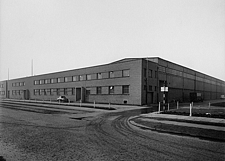 |
|
 |
|
 |
|
 |
| Factory Before Opening, 1954 |
|
Factory Before Opening, 1954 |
|
Team Valley Works, 1956 |
|
Team Valley Works by Night, 1956 |
|
 |
|
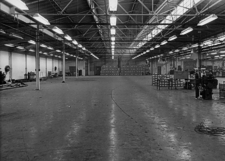 |
|
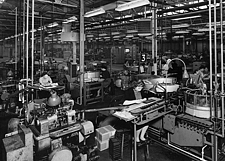 |
|
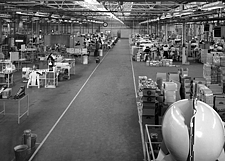 |
| Team Valley Works, c. 1960 |
|
General View of Factory, 1954 |
|
General View of Factory, 1955 |
|
General View of Factory, 1956 |
Photographs - Miniature Lamp Production(1)
|
 |
|
 |
|
 |
|
 |
| Miniature Bulb Blowing, March 1959 |
|
Miniature Bulb Blowing, June 1959 |
|
Flashlight Lamp Production |
|
Telephone Lamp Section, March 1959 |
|
 |
|
 |
|
 |
|
|
| Special Miniature Section, 1955 |
|
Lilliput Decoration Lamps, March 1960 |
|
Lilliput Set Assembly, June 1960 |
|
|
Photographs - High Wattage Production(1)
|
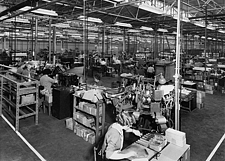 |
|
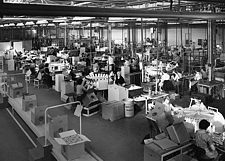 |
|
 |
|
 |
| High Wattage Section, 1955 |
|
High Wattage Section, c.1956-60 |
|
300-1500W Straight Line Group, 1959 |
|
200-300W Packing, March 1960 |
|
 |
|
 |
|
 |
|
|
| Conveyor to Stores, May 1959 |
|
High Wattage Photometry, c.1956-60 |
|
Photometry Section, November 1959 |
|
|
| 1 |
Osram Team Valley Factory Photo Album 1954-60, recovered during demolition of Osram Wembley buildings. |
| 2 |
Osram-GEC Lamp Catalogue, 1951. Wembley |
| 3 |
Private Communication, Ken Foreman - ex-Osram-GEC, 2012. |
| 4 |
Private Communication, Graham Skeldon - Osram Wembley, 1995. |
|
|
|
|
|